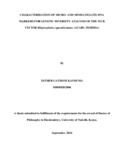| dc.description.abstract | Rhipicephalus appendiculatus (Acari: Ixodidae) is the tick vector of Theileria parva, the causative agent of East Coast fever (ECF), considered to be the most important disease of cattle in 11 countries in Sub-Saharan Africa. ECF kills some one million cattle per year and is responsible for nearly half of calf deaths where the disease occurs. It is associated with high levels of mortality, especially in exotic and cross-bred cattle and is a major constraint to improvement of livestock production in East, Central and Southern Africa. Previous studies on variation within R. appendiculatus have focused on biological and behavioral differences between populations from different geographic regions. However, the genetic diversity and population structure of this important tick vector remains unknown due to absence of appropriate genetic markers. Thus molecular tools are required to characterize the genetic variation of R. appendiculatus and other rhipicephaline species in order to develop optimal control strategies for tick-borne diseases (TBDs). Expressed Sequence Tags (ESTs) and sequenced data such as bacterial artificial chromosome (BAC) are valuable resources for identifying micro- and minisatellite markers through data mining. This approach is fast, inexpensive and efficient. The availability of ESTs and BAC sequences for R. appendiculatus provided a unique opportunity to develop micro and minisatellite markers to accelerate research aimed at studying the population structure and genetic diversity of this important tick vector. This study focused on the development and evaluation of a panel of micro- and minisatellite markers which were used to characterize the genetic diversity within and between populations of R. appendiculatus and other rhipicephaline species. The sequences of the mitochondrial cytochrome c oxidase subunit I (COI), 12S rDNA and the complete nuclear second internal transcribed spacer (ITS2) were used to confirm the taxonomic status of R. appendiculatus and define the phylogenetic relationship between R. appendiculatus and three other closely related rhipicephaline species which are difficult to discriminate phenotypically due to their morphological similarities. Sixty six micro- and minisatellite markers were identified through analysis of the R. appendiculatus Gene Index (RaGI) EST database and selected BAC sequences. PCR primers were designed to flank these 66 markers and tested. Twenty nine markers all from the EST database were found to be polymorphic and therefore informative for genetic studies. These markers were used to genotype 979 individual ticks from 10 field populations, 10 laboratory-bred stocks and five additional rhipicephaline species. Based on the alleles generated, the percentage Principal Component Analysis (PCA) implemented using Multiple Co-inertia analysis (MCoA) clustered populations of R. appendiculatus into two groups. Twenty-three out of the 29 polymorphic EST markers generated amplicons in R. zambeziensis, R. praetextatus, R. pravus, R. pulchellus, and R. evertsi. Genetic diversity analysis showed that the phylogeographic structure of R. raphic structure of R. appendiculatus may not be influenced by animal hosts and agroecological factors. STRUCTURE and discriminant analysis of principle components (DAPC) revealed a very weak genetic structure/substructure and differentiation among field ticks. The spatial genetic structure was characterized by a significant pattern of lack of isolation by distance with no evidence for the presence of distinct genetic clusters for the field tick populations. Phylogenetic analysis of COI identified two major haplogroups of R. appendiculatus in Kenya. Mismatch distribution analysis based on the COI gene revealed that one of the haplogroup has diverged from the other and has experienced recent sudden population expansion at a much faster rate than its ancestor.Analysis of the ITS2 gene in R. appendiculatus suggested high conservation of this gene within tick species while the 12S rRNA gene resulted in two major haplotypes that closely correlated with those of COI gene. COI and 12S rRNA genes were found to be good genetic markers for intra-species population genetic studies of R. appendiculatus compared to ITS2. Results of this study revealed that the genetic differentiation of R. appendiculatus may not be just driven by agro-ecological and climatic factors as previously thought and thus identifying other forces driving its differentiation may help in understanding the apparent sudden population expansion observed within the Sub-Saharan region. The findings of this study may have important taxonomical and distribution implications for R. appendiculatus and may point to an ongoing speciation in Sub-Saharan Africa where the tick occurs. Knowledge of the population structure of R. appendiculatus and its determining parameters is crucial in understanding the dispersal and transmission dynamics of the vector and its pathogens. Understanding the population structure of R. appendiculatus would be important in the design of sustainable control strategies as different tick populations may present differences in vector competence, rates of infectivity with T. parva and acaricide resistance. Thus, it is important to establish how the biology of the two major halogroups compares in regards to acquisition and transmission of ECF as this may be useful in the design and implementation of effective control strategies including the development of effective anti-R. appendiculatus tick vaccines. | en_US |

